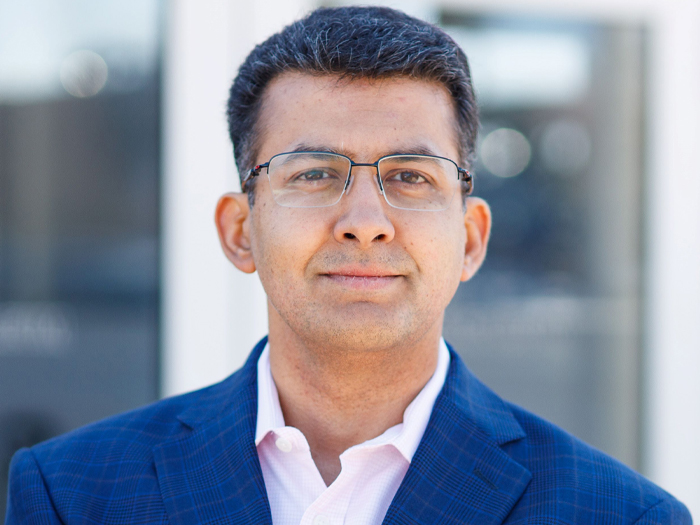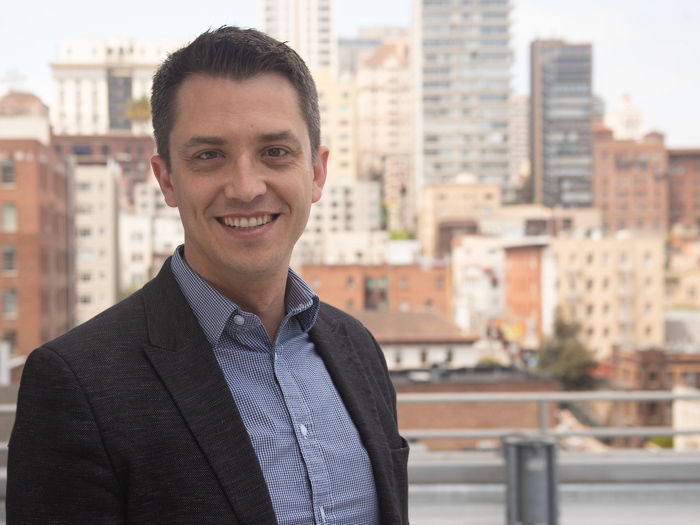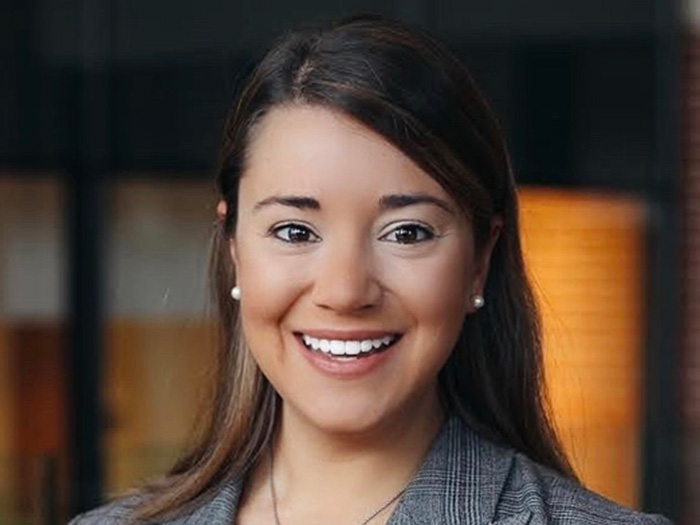9 Questions for MedRisk CEO Sri Sridharan

At National Comp in Las Vegas this September, Dan Reynolds, editor-in-chief of Risk & Insurance, caught up with Sri Sridharan, the newly appointed CEO of MedRisk. What follows is a transcription of that discussion, edited for length and clarity.
Risk &Insurance: When we get a chance to talk to CEOs, we want to hear what’s going through their minds, what opportunities they’re excited about. On that front, as you take this position, what opportunities are you looking forward to?
Sri Sridharan: There are two things that excite me when I think about this space. One, it’s workers’ comp. I’ve been in this space for a long time, since I got out of school in 2003, 2002, with Marsh, MagnaCare and others.
Now with MedRisk, being there for somebody at the time of need, helping them get better, the social purpose that comes with this industry that we are in is always super exciting.
There are not many industries where you get to connect with somebody at the time of need and be able to assist them in a way that makes a big difference in their quality of life and their ability to do things that they love.
R&I: Did that part of this attract you to workers’ comp from the beginning, when you came out of school? Or did it dawn on you as you got to know the business?
SS: It dawned on me as I spent more time in the business. I grew up in India and went to the University of Michigan for financial engineering and industrial engineering. I didn’t know workers’ comp existed.
After school, I joined Marsh and was attracted to the position because it was a consulting role. I wanted to do multiple things, multiple industries, learn different things at the same time.
That’s how I got into this industry. But pretty quickly, I realized this is a unique opportunity to help people in a way that you cannot do in many industries.
That is very exciting for me, as I think about all the roles I’ve had. This work is more focused on “How do we help that employee, that patient get better, get back to health, get back to work, and get back to that pre-injury state so that they can be more productive, more happy, more engaged in life?”
R&I: Thanks for that, Sri. A lot of folks that are running claims organizations are having challenges around labor and talent. How is that sitting with you right now and how does that challenge look?
SS: I think the difficulty is, how do you make sure everybody sees the ultimate purpose we have in helping a patient return to their previous self? We are here to help the patients to get back to their previous range of movement in a way where their pain is manageable.
If you think about physical therapy specifically, and taking in mind our data, over 60% of lost-time claims have a PT script on them. That’s a lot of claims, many of them musculoskeletal. Those involve pain and need to manage pain, get better, get back to function.
Number two, we’re aware of multiple tools that we can use to manage pain. You can go get opioids, get a script, take pain medication and go down that path. You can go get surgeries, and then you can go work with a therapist, get better over a period of time, strengthen all the muscles that you need to strengthen and get back to a long-term recovery process.
As you know, the use of opioids is coming down for all the right reasons. We are seeing fewer surgeries over a period of time and [that] was accelerated by COVID.
PT is evolving more and more to be a safer and more effective alternative to some of the other interventions we have. So through that lens, I worry whether we do have adequate physical therapists available to us. I think, unlike the primary care physicians and specialists, the pipeline for PT looks pretty good. So, I don’t see any major stressors in that regard.
Our clients are facing a different set of challenges. The average tenure of claims professionals has dropped significantly and the talent pool is shrinking. This leaves them with smaller, more inexperienced teams. It’s a major focus of ours when we are coming up with new solutions. We don’t only look at the clinical side of PT.
We’re also looking at how we can contribute meaningfully to the broader claims process and reduce the overall mental and administrative load faced by our clients. In practice, it ranges from creating a cleaner scheduling process to delivering data and information in a way that enables faster, easier decision-making.
R&I: Could it be that the cost of entry is lighter?
SS: It is. And in addition, more and more schools are seeing the trend and offering training in this area. If you think about primary care providers or specialists, you’re looking at an 11-to-13-year incubation period. This is a good deal less than that.
That gives us a faster reaction to the market conditions if you can think about it that way. So we have a lot of opportunities in front of us.
For MedRisk, I’m less worried about finding talent. I’m more worried about, how do we make them see what we are trying to accomplish? You may be scheduling, you may be processing a bill, you may be solving billing inquiries from the provider. You may be networking with the providers to get them into the network, but how do we make sure that everybody, the 1,250 colleagues we have, can understand our core purpose?
It is to help somebody who is in pain when they call you to make sure that you help them in that recovery process, make sure they have a good outcome at the end of the day. I see that as more of a challenge than finding talent.
A related concern is, how do you not silo them? How do you make sure that they understand the ecosystem? How do they work with each other? How do they keep that purpose top of the mind? [That’s] the challenge that we are always focused on, if that makes sense.
R&I: As the leader, you know what you want to do, you know how you feel about it, and then I suppose there is this tension and anxiety because you’re trying to help everybody else understand what you’re trying to accomplish.
SS: Exactly. And that comes from communication.
We do a lot of videos now every week, every month that we send to everybody. We just repeat that message every single time.
“This is why we do this. Don’t lose focus on that.”
I think that’s going to be the biggest differentiator we are going to have. If we can get everybody rolling in one direction, focused on the patient, helping them get better.
Once you operate in this world, you immediately realize it’s absolutely critical to get injured workers to the right providers. It’s absolutely critical to do that as soon as you possibly can.
It’s just as important to make sure that you manage the care while they are with the PT provider. It’s critical to pay the providers as fast as you can, otherwise you’re not going to have a robust network to pick from.
R&I: Sri, you’ve got the engineering background from the University of Michigan. Technology, of course, has a role in what we’re doing. What has MedRisk implemented lately in the technology space that you’d like our readers to know about?
SS: So, I’m a data guy, a data geek if that’s a better word for it. MedRisk has been doing this for 27-plus years.
If you think about a person who spends the most time with the patient, it’s the therapist — more than others in the ecosystem.
The therapist spends 90 minutes two to three times a week for six to eight weeks. So that gives us a richness of data in those notes about that patient that others may not have.
Then think about the barriers to recovery and the methods to overcome those barriers. Other inputs such as social determinants of health, psychosocial, behavioral and comorbid conditions also have a big impact on the recovery.
So then put those two things together. How do you understand the patient beyond, you have back pain — do you like the job you do? How is your family situation? Do you have any comorbid condition that’s going to have a role in your recovery process? Understanding that person is going to be key in delivering the right value to them.
We are well positioned to understand the patient because we tend to spend the most time with the patients. We have that data for six and a half million bills over many years. We process and help more than half a million patients a year.
That’s an unbelievable amount of data that we sit on. Now you think about what technology you bring to bear, whether it is NLP or machine learning or AI that you can use to customize the treatment plan for each person based on their needs, at scale.
That’s what fascinates me. It’s not the technology for the technology’s sake.
It’s, how do I leverage technology to help that patient at scale, at cost, in a way that’s very unique to us?
That’s where we are putting our energy and our investment.
How do we leverage that data? How do we mine that data and how do we deliver insights to adjusters? How do we deliver insights to the patients? How do we deliver insights to the providers in a way that they are going to be able to serve that patient really well? That is what fascinates me.
R&I: Are you satisfied that the organization is moving effectively and practically towards that end?
SS: In a word, yes.
Fortunately, we are sitting on that gold mine, so we’ve been making significant investments in the last 18 months in AI, NLP and analytics capabilities that we have already rolled out to a lot of our clients.
We have our client council in October, and we are going to show them some really interesting applications. Essentially, our focus is, how do you learn that patient and the journey in a way that you could not do before, and then how do you leverage that?
I think that we can do that, and the more we can build around it is pretty exciting for us.
R&I: Thinking about PT and trends — I mean, I brought up telehealth, and perhaps we could talk about that. We had COVID, we had a pretty big shift in how we gave care, how we treated patients. What’s been the legacy of that in terms of telehealth with PT? Is it sticking around?
SS: I think it was one of the valuable ways of delivering the care that we need to deliver. There is a place for it. And post-COVID, we saw the utilization of telehealth come down for the right reasons.
The manual therapy is difficult or impossible through telehealth. So I think there are things that we can do with telehealth, but we need to work towards finding out, here are the pieces, here are the visits that can be a telehealth visit versus here are the visits that need to be an in-person visit.
I think that’s evolving right now, but the lift we saw from COVID, which was needed because of the limitations we had — I think that has dropped down.
R&I: Congrats again on becoming the CEO. Is there anything about the position that I didn’t ask you about, Sri, perhaps challenges or opportunities that you were thinking about when you woke up this morning thinking, “OK, I’m the CEO. What do I need to do?”
SS: Again, it comes back to a few things that I always think about.
How do we make sure that everybody understands our purpose? How do we make sure that people give each other the benefit of doubt, work with each other, and don’t form silos. I think that’s the big cultural aspect of what we are trying to accomplish.
At MedRisk, the culture is amazing. Our people have been doing this for a long time. They truly believe in what we do. They are super engaged with our clients, with our patients, our providers. The culture that we have built over the last 20-plus years is unbelievable to watch.
I’m proud to be part of this organization and I think the talent we have is the best in the space. &










